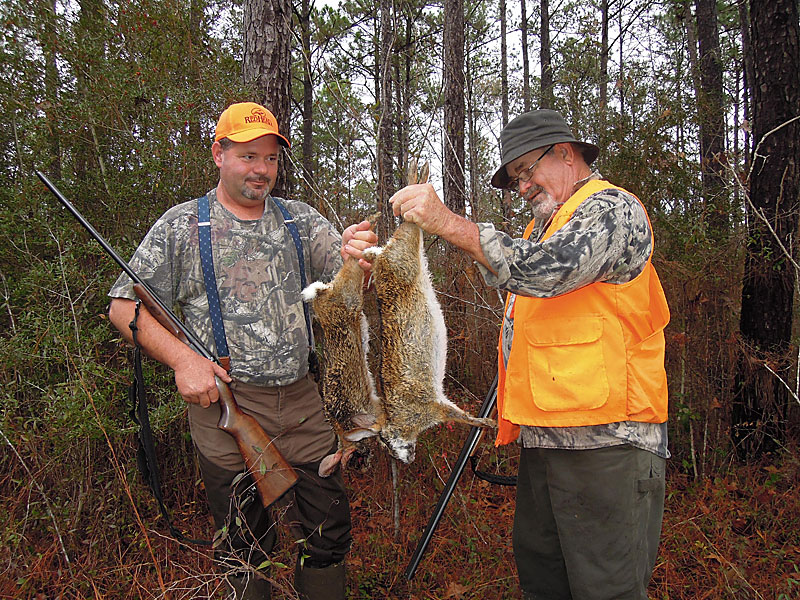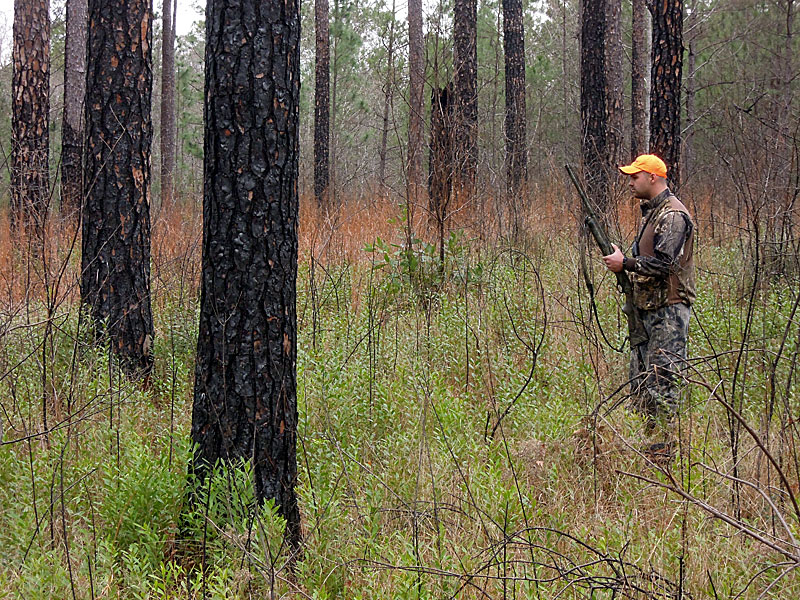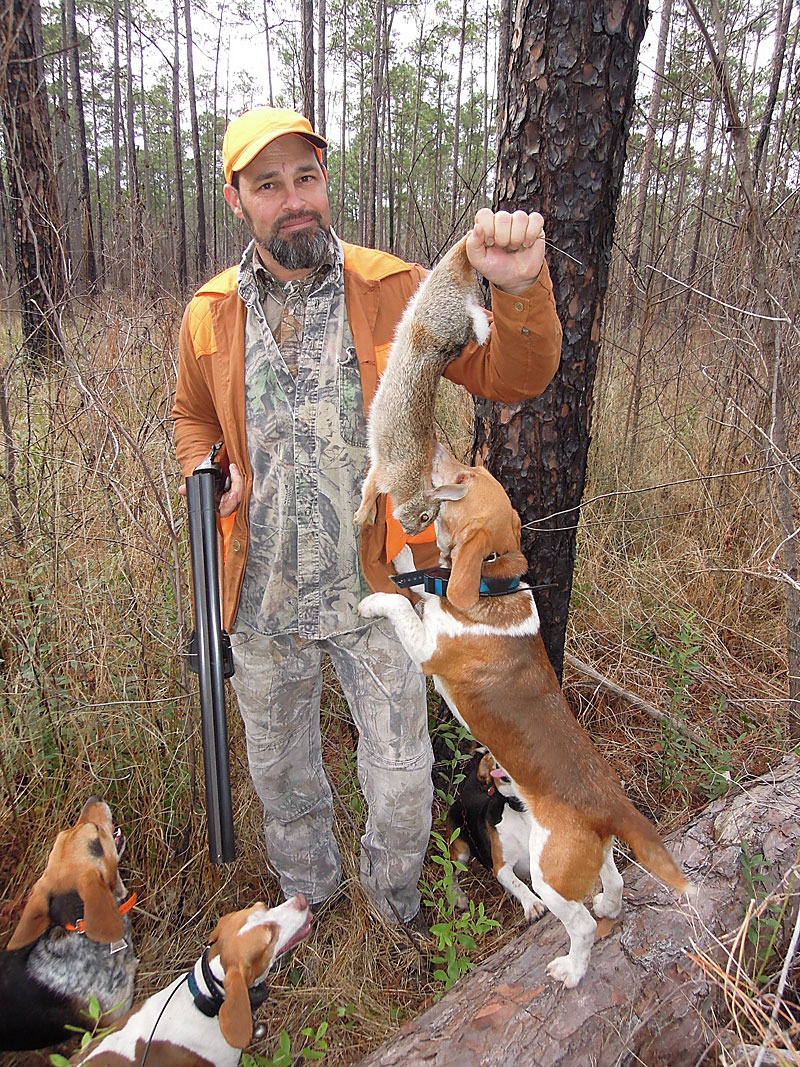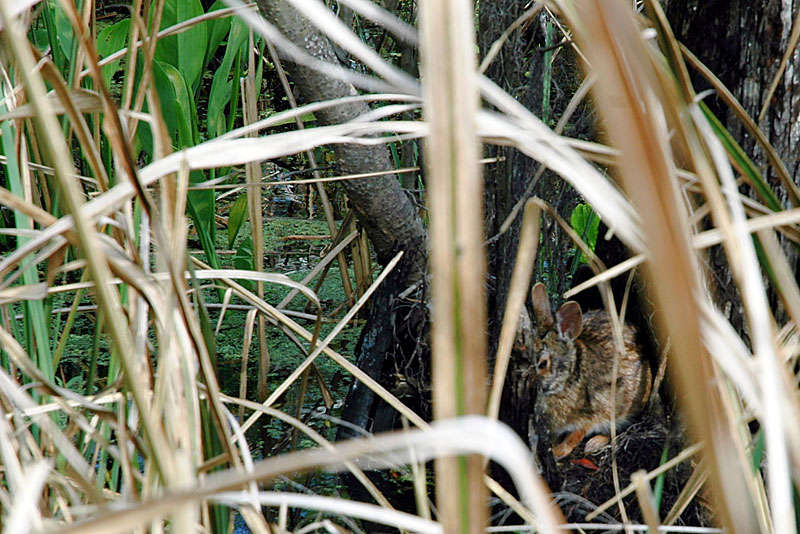
Hunting rabbits is a blast, but it isn’t as easy as most people think
“How tough could hunting rabbits with dogs be?”
I thought driving to the forest one chilly morning. “Dogs do all the work. They go through brush and briars flushing rabbits. I just need to wait for the ‘doggone galoot,’ as Yosemite Sam says, to pop out from cover so I can blast him.”
An hour later, tensed with high anticipation and adrenaline, I listened to frantic howling moving ever closer across the pine savanna with backlighted trees blazing orange from the rising sun. To get a better shot, I repositioned to a small clear patch between two thickets where I knew the rabbit would certainly pass.
Then, I heard something about 40 yards behind me. I turned just fast enough to catch a fleeting glimpse of a white puff vanishing into a brushy thicket. I never saw it again, or any other live rabbits that day. Sam never got his “long-eared varmint” either, but several of my more experienced companions did bag several bunnies.
“The biggest mistake people make when rabbit hunting is trying to chase the dogs instead of letting the dogs come to them,” said Collins Jenkins from Pine Grove in St. Helena Parish. “Someone who tries to follow the dogs will always be behind the rabbit.”
Where did it go?
Most of that frosty morning, I did exactly what I shouldn’t have done. Whenever the beagles started howling, I maneuvered to where I thought a rabbit would suddenly erupt from cover with the pack in hot pursuit. At one point, several dogs with their noses pressed to the ground passed barely a few feet from me. However, that bunny had disappeared long before I ever saw the dogs. A beagle might be right on a rabbit’s tail, but when running for their lives, rabbits like to put as much territory between themselves and the pack as possible.

“Hunting rabbits with dogs is not as easy as some people think,” said Toby Dooly from Sarepta in Webster Parish. “When someone jumps a rabbit, it normally runs in a big circle and will come back to where it started. Find where the dogs first jumped the rabbit and stay there still and quiet. Wait for that rabbit to come back home.”
With every predator trying to eat them, rabbits know how to disappear. They make their homes in the thickest cover. What looks impassable to humans contains numerous small tunnels and trails large enough for a rabbit to navigate with ease. People might not pass through such cover easily, particularly a big guy like me. However, short-legged dogs, especially beagles, can root out rabbits from their lairs in entangling thickets impassible to humans.
“A rabbit is hunted day and night from all kinds of predators on land and in the air,” said James Sealy, Jr., who hunts the Desoto National Forest near Hattiesburg, Miss. “He likes his home territory and knows every hole, briar patch and grass clump in it. Rabbits are constantly trying to avoid predators much more skilled than human hunters. They can see a person and disappear without that person ever knowing it.”
Many people get into hunting rabbits because of family traditions. They begin by following their fathers, grandfathers or other relatives at a very young age. Later, they pass that heritage down to the next generation.

“I grew up rabbit hunting,” Dooly said. “My dad, grandpa and uncles hunted rabbits. Sometimes, we’d hunt some dogs in the morning and others in the evening. We’d bring a grill and barbecue rabbits for lunch, then go back hunting again in the afternoon. If people would get involved with it, they would enjoy rabbit hunting with dogs. We do a lot of walking, but we have a great time.”
Social hunting
Rabbit hunters can socialize. They don’t need to sit alone in a freezing tree for hours. They can talk and move around. Dog hunters know and love the sound of their animals. They can pick out individual animals from a howling pack. Frequently, dog enthusiasts hold informal competitions to see which dog finds the first or most rabbits and chide each other in friendly banter when a hunter or the dog messes up.
This social atmosphere makes rabbit hunting such a great way to introduce children or novices to the sport. If nothing else, new sportsmen will get a thrill from hearing the dogs and watching them work.
“I’ve had my own pack of dogs since I was in middle school,” said Jenkins, who came from a long line of rabbit hunters. “I was probably about five years old when I killed my first rabbit. I love to bring youth or inexperienced hunters with me and see their reaction. Their faces light up when they hear the dogs running a rabbit or kill one.”
With multiple hunters participating, sportsmen might only release a few dogs at a time. When they move to another spot, the group releases fresh dogs to avoid over exhausting any animals. A good rabbit dog might run 20 miles in a day, so it needs occasional rest.
After releasing the dogs, spread out to safe distances. Look for spots that allow some visibility. Listen to the dogs and watch any openings where a rabbit might appear. Determine safe places to shoot and never fire until positively identifying the target and what’s behind it. Something low to the ground and brown in heavy cover could be a dog, not a rabbit.
“In North Louisiana, we usually hunt forests with a mixture of cutovers and pine thickets with grown up fields,” Dooly said. “We’ll look at the habitat and come up with a game plan to post people in the best spots where they might see a rabbit, but they can safely shoot without hitting anyone.”
Safety first
Each participant should wear an orange cap and vest plus brush-buster pants. Also communicate with each other. Make sure everyone knows where all others stand. In thick cover, people might not see a person 30 yards away, even when wearing orange. Many hunting teams bring light, short-range radios to keep track of everyone and hear updates on what the dogs and rabbits are doing.
Jenkins usually hunts pine forests in St. Helena and Livingston parishes, but he also hunts marshy Plaquemines Parish. In the delta marshes, rabbits can’t find much dry ground, so any land above the high tide line makes a great place to look for game. Levees bordering pipeline canals or other waterways and natural high ground surrounded by water can concentrate rabbits in huge numbers, particularly at high tide.

Such patches of high ground surrounded by marsh grow notoriously thick with underbrush. Often, hunters can’t see more than 10 yards in any direction. Even in pine country, shots seldom come at more than 30 yards. Rabbits don’t like to venture far from cover during daylight hours.
When a rabbit rockets from a thicket, sportsmen need to react quickly. A light, short-barreled 20- or 28-gauge shotgun with a modified or improved cylinder choke loaded with Number 6 to 8 shot makes a great rabbit gun. Some hunters love .410 double barrels. It doesn’t take much to kill a rabbit if someone can put a couple pellets into it.
Louisiana and Mississippi sportsmen can hunt both swamp rabbits and cottontails. Both species commonly share many tracts, but cottontails prefer drier upland country. Excellent swimmers, swampers readily take to water. Sometimes, they jump into small creeks and hide under overhanging brush, logs or root masses. They stick their noses out of the water just enough to breathe. A swamp rabbit typically runs farther than a cottontail, but a cottontail runs more erratically.
“A ditch bank or a waterhole is a good place to stand,” Jenkins said. “Often, a rabbit will go to water to try to throw the dogs off the scent, especially a swamp rabbit. A little stream might have more openings where people can see rabbits better. Get in a spot with more visibility to better see rabbits.”
Tag along

People who want to start hunting rabbits with dogs should find someone who does it and tag along. Once that person learns a few things and enjoys the sport, that person might consider buying some pups and training them. Pair young dogs with experienced dogs and the pups will learn from the older ones.
“Most rabbit hunters are more than happy to take others hunting,” Dooly said. “It’s a family-oriented style of hunting. I’ve killed many rabbits in my life. I’m there more to watch and work the dogs than I am for killing rabbits. I like to see who has the better dog at the end of the day. I usually let the kids and new people do all the shooting. Many people would enjoy it if they ever tried it.”
Most rabbit hunters probably release their dogs with permission on private lands, but many public properties in both Louisiana and Mississippi hold good rabbit populations. Any place where rabbits can find abundant undergrowth to hide from predators and succulent foods to nibble, people should find rabbits.